peregrines
Super Moderator/Fly Swap Coordinator
- Messages
- 4,009
- Reaction score
- 30
[TABLE="head]{colsp=2}
Clouser Deep Minnow and Kreh Wing Style Clouser |
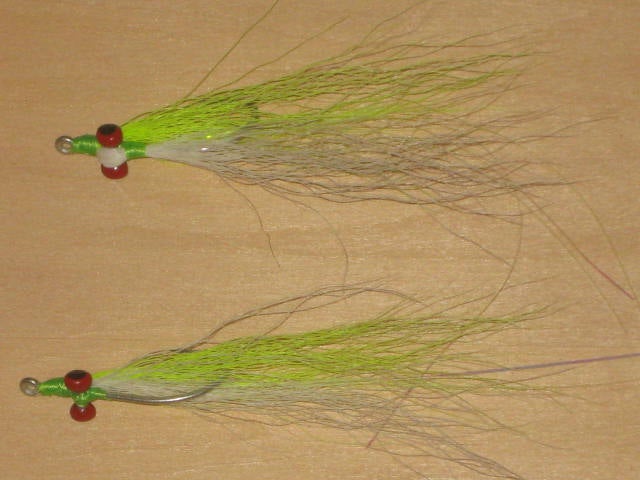
Type of fly | Classic Saltwater baitfish bucktail streamer
Originator of pattern if known | Generally attributed to Bob Clouser from Pennsylvania
Tied and Submitted by | peregrines
Level of tying experience needed to tie this pattern | Beginner, a fairly simple pattern using basic tying skills. This pattern is part of the upcoming beginner series of both warmwater and saltwater fly patterns. In addition to being a great pattern to have in your box, tying this fly will introduce the following techniques: Securing dumbbell or bead chain eyes using an X Wrap and Cinch Wrap, securing synthetics and other slippery material using a Lock Wrap, measuring a hair wing for length and figuring out how much to use by sizing a bundle of solid hair (amount of bucktail).
Materials from left ...Hooks on the top is an example of an inexpensive saltwater hook (that can also be used in fresh) a Mustad 3407DT size 2 and below it an inexpensive Mustad 3366 size 6 for if you'll be just using it in freshwater.... Strong thread with a high breaking strength, Danville's Flat Waxed Nylon here.... Eyes either Bead chain (a length of chain is clipped into pairs of eyes with a pliers) and plain and painted lead dumbbells of various sizes..... Flash material usually Flashabou or Krystal Flash is used between the layers of the wing....Bucktail used in the wing (a popular combination of White and Chartreuse shown here but the possibilities are endless. Other materials like hair from Fox Tails may be used for smaller flies and some synthetics are used for longer flies) |

Materials listed in order of tie in:|
Hook | If there's any chance you'll be using this pattern in salt water, use a saltwater hook. A standard length is preferred to reduce fouling, but you can use a longer hook. Hook size to match baitfish commonly size 4-2/0, with smaller patterns 8-4 often tied using tail hair from fox, raccoon, skunk, red fox squirrel or coyote. There's 3-4" practical length to bucktail but for longer flies a stiff synthetic like super hair can be used in place of bucktail. A size 2 saltwater hook, the inexpensive Mustad 3407DT is used here. An inexpensive option for freshwater is a Mustad 3366 sized anywhere from 10 to 6 for crappies and 4 to 1/0 or so for freshwater bass.
Thread | A strong thread with a high breaking strength is needed to get the necessary tension to hold eyes in place. Danville’s Flat Waxed Nylon is used here.
Eyes | Dumbbell or Beadchain, size and weight up to you, just be aware that clousers can cause immediate breakage (and future due to stress fractures ) when they clunk into a graphite rod on the back or forward cast. They can also raise a bump on the back of your head, so wear a hat (or helmet) and shatter proof sunglasses (always a good idea, but particularly so with Clousers). On this size 2 I use a 1/8th inch diameter dumbell (labels vary but for something similar you might see stuff labeled 5/32 inch, X Small, or 1/50 oz). The same diameter beadchain will give a slower sink rate, as different metal dumbbells. The same size brass dumbbells will sink slower than lead but faster than beadchain
Tail | None
Body | None
Wing | Wing of bucktail ( or other material) in 1 or more sparse layers, 2x length of hook. Endless color variations, with Chartreuse over White being one of the most popular
Flash | Usually a few doubled strands of Flashabou or Krystal Flash sandwiched between layers of the wing. Let the flash material extend 1/2" beyond the bucktail wing for an added sumthin' sumthin in the water.
Head | Thread.
Special tying notes | Keep this fly sparse!
Clouser Deep Minnow
Tie on at the forward 1/3 point of shank. Proper eye placement is important for the swooping/diving action of the fly like a baitfish fleeing to the bottom-- too close to the eye and it will act more like a jig with a more up and down vertical motion |
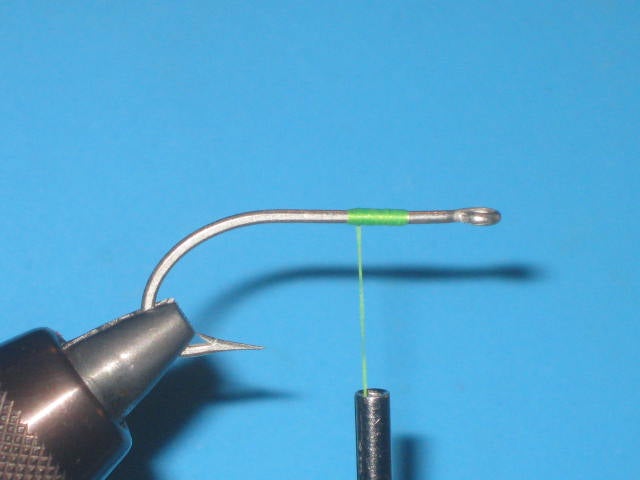
Build thread bumps to nestle the dumbbell or beadchain eyes. |
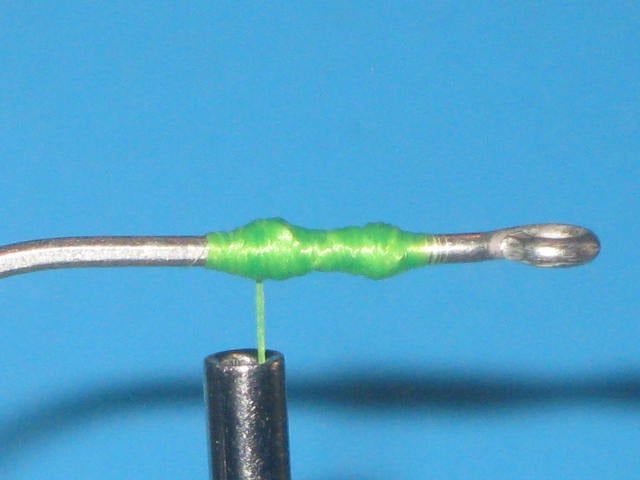
Place the eyes on top of the shank between the thread bumps |
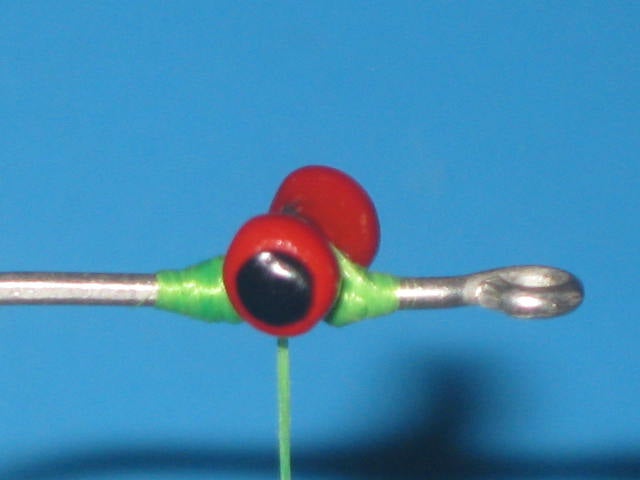
Figure 8 Wrap the eyes in place:..... starting with the thread in front of the eyes on the far side of the shank... bring the bobbin under the shank in front of the eyes on the near side... over the top between the eyes and down on the far ... under the shank behind the eyes to the near side behind the eyes... up from the near side behind the eyes across the top between the eyes and down on the far size.... You've just X Wrapped the eyes and have ended up where you started on the far side of the hook in front of the eyes.... Complete several more x wraps under thread tension to securely bind the eyes to the shank. Test to make sure you can't wiggle them easily off to one side and add more tight turns if necessary |
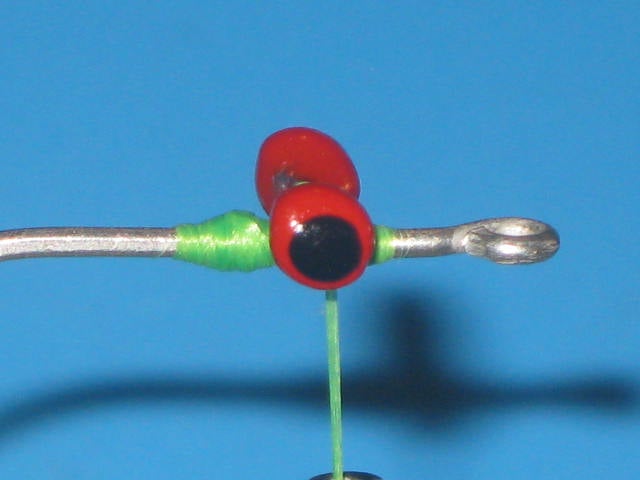
Once you have them securely in place, rotate the spool of thread to decrease the distance between the tip of the bobbin and the eyes on top of the shank |

Take several tight turns of thread BETWEEN the eyes and the top of the hook shank (not around the hook shank)..... These wraps will act as a belt cinching the x wraps even tighter to help keep the eyes in place.....If you plan to tie up a bunch of these, this is a good place to tie off. Keep tying a bunch of them to this point and coat them with a couple of layers of head cement (letting it dry between layers). This will add more durability.... Once dry, you can tie on again and complete the fly |
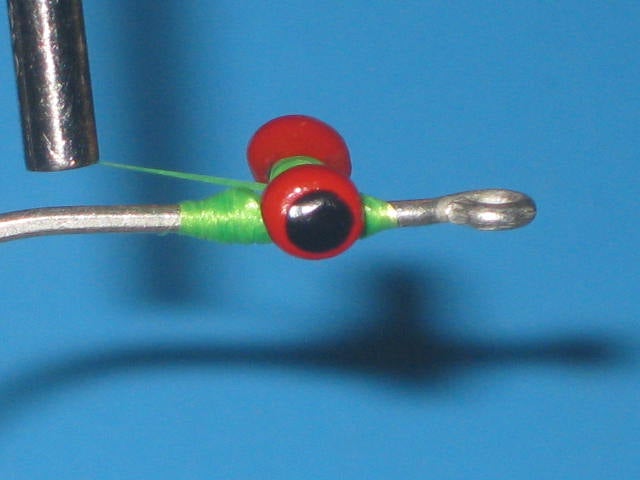
If you tied off to coat with head cement, tie on again to continue. Build a smooth thread base in front of the eyes |
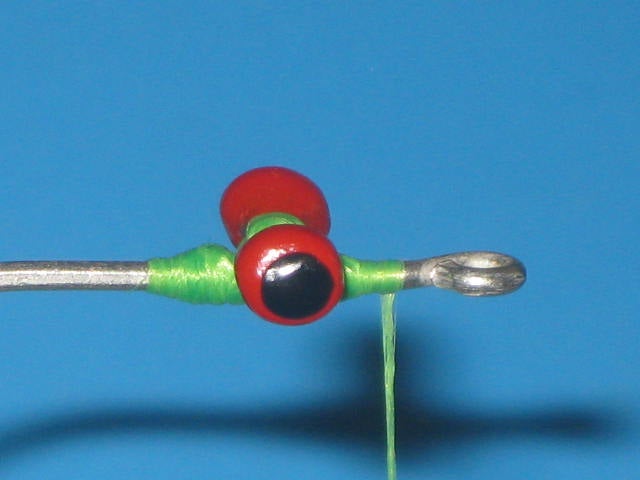
Select a bunch of white bucktail and even up the tips by hand. I like to keep the bucktail wing sparse...... To get a sense of a good amount to start with, pinch a bunch of bucktail between the thumb and index fingers of both hands, leaving a small 1/2" section showing in the middle between your two hands. Give each hand a 1/4 turn in opposite directions to twist the bundle. Compare the size of the twist to the outside diameter of the hook eye. If it's about the same, you're good to go. The amount of hair you use is of course up to you, but thicker bundles of hair can be more difficult to securely attach, will sink slower, be more wind resistant, and often have less action in the water..... Even out the tips by hand, generally these flies look better with roughly evened tips than they would if the bucktail was stacked with perfectly aligned tips resembling a paintbrush... Using an Angle Wrap to let thread torque position the wing, tie on a length of bucktail about 2 hook lengths long and secure with tight thread wraps in front of the eyes |

At this point, the bobbin should be hanging on the far side of the hook in front of the eyes. Bring it across the bottom of the shank behind the eyes on the near side and over the top to the far side behind the eyes. Make several more tight wraps to bind the bucktail down to the shank directly behind the eye |
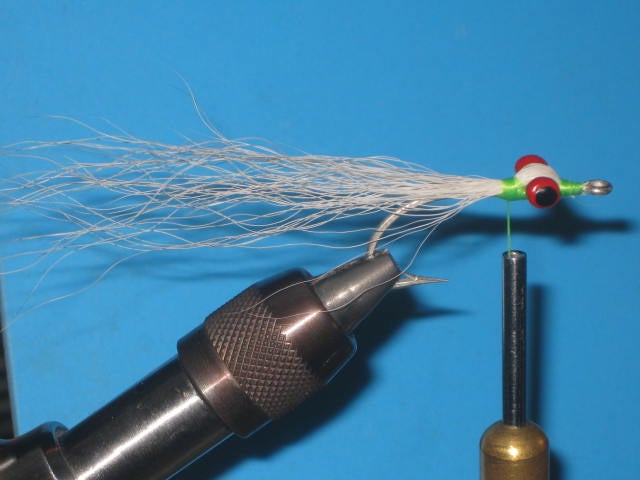
If the jaws of your vise rotate, spin the vise so the hook point is up. If your jaws do not rotate, just reposition the hook in the jaws. The rest of the fly will be completed on what is now the "top" of the inverted shank. |

Take a couple of strands of Flashabou or Krystal flash and capture them in the middle with thread, and slide them into position on what is now "the top" of the inverted shank behind the eye and take one or two complete wraps of thread around the shank |
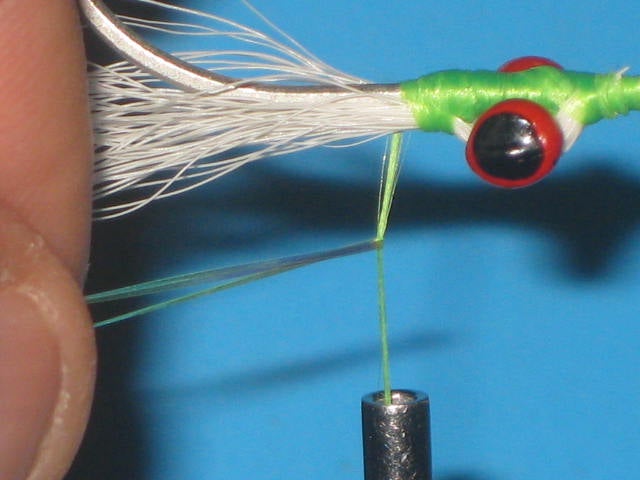
Because synthetics are slippery we'll use a Lock Wrap, trapping the middle of the strands between a few wraps of thread then doubling the front end of the strands back and over wrapping with tight wraps.... Unfold the doubled strands of Flashabou or Krystal Flash at the middle, with one end towards rear and one end facing over the front of the hook. Stroke both ends towards rear of hook and take several wraps around the doubled strands. The strands should extend beyond the bucktail at least 1/2" |

After securing the flash material, take a wrap from the far side behind the eye and complete a wrap in front of the eye..... Cut a bunch of chartreuse bucktail and even the tips by hand...... Measure out the bucktail so it extends approximately 2 hook lengths from the tie-in point ahead of the eyes.... Take several tight wraps to secure, and whip and tie off. Coat head with several coats of head cement |

Clouser Deep Minnow Lefty Kreh style |
Here's a variation of the wing, all wing materials are tied on directly in front of the eyes. Tie on eyes as before and invert shank. |
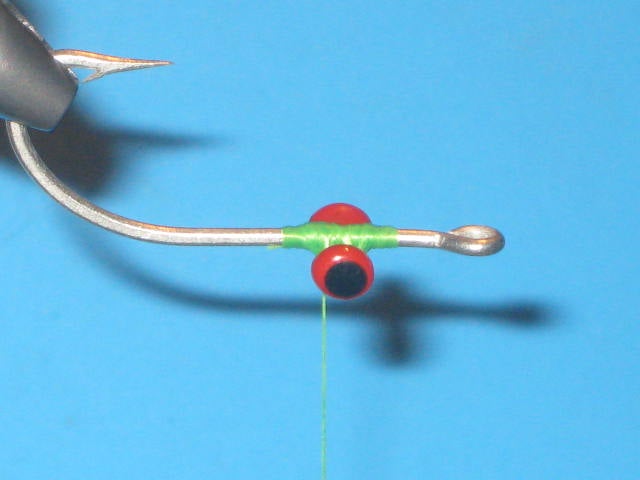
Add white bucktail ahead of dumbbell eyes... |

Add flash... |

Add Chartreuse bucktail, whip finish, cut thread and coat with a couple layers of head cement or Sally Hansen's Hard As Nails.... |

Target species | Everything that swims
Fishing notes | Great to puff along a sandy or muddy bottom, and the hook point up position helps avoid hanging up around rocks.
[/TABLE]
Clouser Deep Minnow and Kreh Style Clouser Under construction will add rest tomorrow sorry for the tease...
Clouser Deep Minnow and Kreh Wing Style Clouser |

Type of fly | Classic Saltwater baitfish bucktail streamer
Originator of pattern if known | Generally attributed to Bob Clouser from Pennsylvania
Tied and Submitted by | peregrines
Level of tying experience needed to tie this pattern | Beginner, a fairly simple pattern using basic tying skills. This pattern is part of the upcoming beginner series of both warmwater and saltwater fly patterns. In addition to being a great pattern to have in your box, tying this fly will introduce the following techniques: Securing dumbbell or bead chain eyes using an X Wrap and Cinch Wrap, securing synthetics and other slippery material using a Lock Wrap, measuring a hair wing for length and figuring out how much to use by sizing a bundle of solid hair (amount of bucktail).
Materials from left ...Hooks on the top is an example of an inexpensive saltwater hook (that can also be used in fresh) a Mustad 3407DT size 2 and below it an inexpensive Mustad 3366 size 6 for if you'll be just using it in freshwater.... Strong thread with a high breaking strength, Danville's Flat Waxed Nylon here.... Eyes either Bead chain (a length of chain is clipped into pairs of eyes with a pliers) and plain and painted lead dumbbells of various sizes..... Flash material usually Flashabou or Krystal Flash is used between the layers of the wing....Bucktail used in the wing (a popular combination of White and Chartreuse shown here but the possibilities are endless. Other materials like hair from Fox Tails may be used for smaller flies and some synthetics are used for longer flies) |

Materials listed in order of tie in:|
Hook | If there's any chance you'll be using this pattern in salt water, use a saltwater hook. A standard length is preferred to reduce fouling, but you can use a longer hook. Hook size to match baitfish commonly size 4-2/0, with smaller patterns 8-4 often tied using tail hair from fox, raccoon, skunk, red fox squirrel or coyote. There's 3-4" practical length to bucktail but for longer flies a stiff synthetic like super hair can be used in place of bucktail. A size 2 saltwater hook, the inexpensive Mustad 3407DT is used here. An inexpensive option for freshwater is a Mustad 3366 sized anywhere from 10 to 6 for crappies and 4 to 1/0 or so for freshwater bass.
Thread | A strong thread with a high breaking strength is needed to get the necessary tension to hold eyes in place. Danville’s Flat Waxed Nylon is used here.
Eyes | Dumbbell or Beadchain, size and weight up to you, just be aware that clousers can cause immediate breakage (and future due to stress fractures ) when they clunk into a graphite rod on the back or forward cast. They can also raise a bump on the back of your head, so wear a hat (or helmet) and shatter proof sunglasses (always a good idea, but particularly so with Clousers). On this size 2 I use a 1/8th inch diameter dumbell (labels vary but for something similar you might see stuff labeled 5/32 inch, X Small, or 1/50 oz). The same diameter beadchain will give a slower sink rate, as different metal dumbbells. The same size brass dumbbells will sink slower than lead but faster than beadchain
Tail | None
Body | None
Wing | Wing of bucktail ( or other material) in 1 or more sparse layers, 2x length of hook. Endless color variations, with Chartreuse over White being one of the most popular
Flash | Usually a few doubled strands of Flashabou or Krystal Flash sandwiched between layers of the wing. Let the flash material extend 1/2" beyond the bucktail wing for an added sumthin' sumthin in the water.
Head | Thread.
Special tying notes | Keep this fly sparse!
Clouser Deep Minnow
Tie on at the forward 1/3 point of shank. Proper eye placement is important for the swooping/diving action of the fly like a baitfish fleeing to the bottom-- too close to the eye and it will act more like a jig with a more up and down vertical motion |

Build thread bumps to nestle the dumbbell or beadchain eyes. |

Place the eyes on top of the shank between the thread bumps |

Figure 8 Wrap the eyes in place:..... starting with the thread in front of the eyes on the far side of the shank... bring the bobbin under the shank in front of the eyes on the near side... over the top between the eyes and down on the far ... under the shank behind the eyes to the near side behind the eyes... up from the near side behind the eyes across the top between the eyes and down on the far size.... You've just X Wrapped the eyes and have ended up where you started on the far side of the hook in front of the eyes.... Complete several more x wraps under thread tension to securely bind the eyes to the shank. Test to make sure you can't wiggle them easily off to one side and add more tight turns if necessary |

Once you have them securely in place, rotate the spool of thread to decrease the distance between the tip of the bobbin and the eyes on top of the shank |

Take several tight turns of thread BETWEEN the eyes and the top of the hook shank (not around the hook shank)..... These wraps will act as a belt cinching the x wraps even tighter to help keep the eyes in place.....If you plan to tie up a bunch of these, this is a good place to tie off. Keep tying a bunch of them to this point and coat them with a couple of layers of head cement (letting it dry between layers). This will add more durability.... Once dry, you can tie on again and complete the fly |

If you tied off to coat with head cement, tie on again to continue. Build a smooth thread base in front of the eyes |

Select a bunch of white bucktail and even up the tips by hand. I like to keep the bucktail wing sparse...... To get a sense of a good amount to start with, pinch a bunch of bucktail between the thumb and index fingers of both hands, leaving a small 1/2" section showing in the middle between your two hands. Give each hand a 1/4 turn in opposite directions to twist the bundle. Compare the size of the twist to the outside diameter of the hook eye. If it's about the same, you're good to go. The amount of hair you use is of course up to you, but thicker bundles of hair can be more difficult to securely attach, will sink slower, be more wind resistant, and often have less action in the water..... Even out the tips by hand, generally these flies look better with roughly evened tips than they would if the bucktail was stacked with perfectly aligned tips resembling a paintbrush... Using an Angle Wrap to let thread torque position the wing, tie on a length of bucktail about 2 hook lengths long and secure with tight thread wraps in front of the eyes |

At this point, the bobbin should be hanging on the far side of the hook in front of the eyes. Bring it across the bottom of the shank behind the eyes on the near side and over the top to the far side behind the eyes. Make several more tight wraps to bind the bucktail down to the shank directly behind the eye |

If the jaws of your vise rotate, spin the vise so the hook point is up. If your jaws do not rotate, just reposition the hook in the jaws. The rest of the fly will be completed on what is now the "top" of the inverted shank. |

Take a couple of strands of Flashabou or Krystal flash and capture them in the middle with thread, and slide them into position on what is now "the top" of the inverted shank behind the eye and take one or two complete wraps of thread around the shank |

Because synthetics are slippery we'll use a Lock Wrap, trapping the middle of the strands between a few wraps of thread then doubling the front end of the strands back and over wrapping with tight wraps.... Unfold the doubled strands of Flashabou or Krystal Flash at the middle, with one end towards rear and one end facing over the front of the hook. Stroke both ends towards rear of hook and take several wraps around the doubled strands. The strands should extend beyond the bucktail at least 1/2" |

After securing the flash material, take a wrap from the far side behind the eye and complete a wrap in front of the eye..... Cut a bunch of chartreuse bucktail and even the tips by hand...... Measure out the bucktail so it extends approximately 2 hook lengths from the tie-in point ahead of the eyes.... Take several tight wraps to secure, and whip and tie off. Coat head with several coats of head cement |

Clouser Deep Minnow Lefty Kreh style |
Here's a variation of the wing, all wing materials are tied on directly in front of the eyes. Tie on eyes as before and invert shank. |

Add white bucktail ahead of dumbbell eyes... |

Add flash... |

Add Chartreuse bucktail, whip finish, cut thread and coat with a couple layers of head cement or Sally Hansen's Hard As Nails.... |

Target species | Everything that swims
Fishing notes | Great to puff along a sandy or muddy bottom, and the hook point up position helps avoid hanging up around rocks.
[/TABLE]
Last edited:
